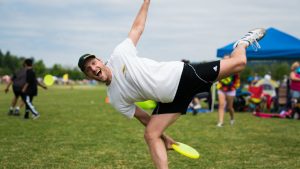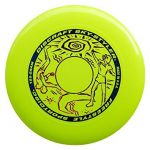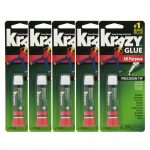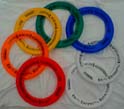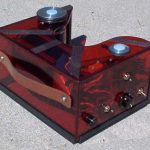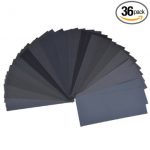When the Frisbee is upside down it must be thrown with the opposite angle. Learn how to do freestyle Frisbee upside down backhand throws from a world champion in this free sports video series.
Category: Beginner
Articles for the new freestyle frisbee skills player.
Freestyle Frisbee Stretches, Backhand & Forehand Throws : Freestyle Frisbee Under the Leg Backhand Throw
The correct grip is essential for executing the under the leg backhand throw. Learn how to do under the leg backhand freestyle Frisbee throws from a world champion in this free sports video series.
Freestyle Frisbee Stretches, Backhand & Forehand Throws : Freestyle Frisbee Chair Throw
The chair throw is a backhand trick throw that is very popular. Learn how to do freestyle Frisbee chair throws from a world champion in this free sports video series.
Freestyle Frisbee Stretches, Backhand & Forehand Throws : Freestyle Frisbee Behind the Back Backhand Throw
To do the behind the back backhand throw the arm comes all the way around and the body turns to allow room to make the throw. Learn how to do freestyle Frisbee behind the back backhand throws from a world champion in this free sports video series.
Word of the Day – Twisted Turkey
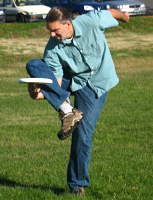 Twisted Turkey: noun. A restricted move, often a catch in Freestyle Frisbee where the arm wraps around the inside leg on the same side. Can be either right arm wrapping around right leg or left arm wrapping around left leg. Ex. “Check out that Twisted Turkey delay!” See also: Figure Four, Perch, Pretzel, or Grape Vine.
Twisted Turkey: noun. A restricted move, often a catch in Freestyle Frisbee where the arm wraps around the inside leg on the same side. Can be either right arm wrapping around right leg or left arm wrapping around left leg. Ex. “Check out that Twisted Turkey delay!” See also: Figure Four, Perch, Pretzel, or Grape Vine.
Freestyle Frisbee Stretches, Backhand & Forehand Throws : Freestyle Frisbee Throwing With Spin
It’s very important to put as much spin as possible when doing Frisbee freestyle. Learn how to throw with spin in freestyle Frisbee from a world champion in this free sports video series.
Freestyle Frisbee Stretches, Backhand & Forehand Throws : Flat vs Angled Backhand Freestyle Frisbee Throw
Beginners should concentrate on perfecting a flat throw. Advanced players should work on angled throws to increase the amount of tricks they can perform. Learn the difference between flat and angled freestyle Frisbee backhand throws from a world champion in this free sports video series.
Equipment -or- Tools of the Trade
So you’ve seen some jammers and you are fired up. They tossed you some spin and a whole new world opened up to you. Now you want to practice but those damn letters on the bottom of the disc keep it from staying on your nail. Don’t fret, the following section will guide you to finding exactly what you need to shred, from the bare necessities to great training devices.
Disclosure: by using these links to purchase, FrisbeeGuru gets a small commission. It costs you nothing extra and helps support our efforts.
The Bare Essentials
To play freestyle Frisbee it is absolutely, positively necessary to have some sort of flying disc. Being as it’s freestyle there are no rules. I’ve been caught air brushing a cd-rom and padiddling my mom’s good china. Jamming can occur at any time, any place with any object. One of my favorite jams was in a bar in Yakima, Washington with a mini disc. All of the best players got that way because they can’t stop playing. Why let a little thing like not having a Sky-Styler or the darkness stop you? You can even chest roll a golf disc if you are careful.
Tried and True, Tools of the Trade
Ok, that was pretty bare. Here are the tools that 90% of professional freestylers use:
The Disc: Disc Craft’s Sky-Styler is the number one choice of flying disc for freestylers. It’s smooth surface, deep rim and just above average weight make it the perfect choice for delays, rim pulls and air brushing in almost any condition.
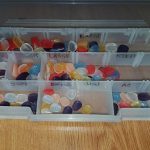
Nails
At an event near you
Fake Nails: Fake nails reduce the friction between your finger and the disc when it is spinning, especially while on a rim delay. They also provide a larger surface on which to delay the disc resulting in greater control. Most people make fake nails out of the tube the krazy glue comes in. Just cut out a piece to fit your finger. Others make the nails out of dental acrylic. These nails last longer and often come in fancy colors. To attach them ignore the warning not to use krazy glue to attach fake nails (at your own risk) and use the Krazy glue to attach the nails. When you are done just jam your thumb nail under one edge and pry them off. The first time hurts, after that it’s a cinch. Not sure about wearing fake nails? Maybe Dan Magallanes can change your mind.
Glue: As mentioned above, glue is used to attach the fake nails. Most players use Krazy Glue for this purpose. It’s what I use. Some players like to add a small dab of rubber cement. They believe this creates a stronger bond while still allowing the nail to be removed. Still other players prefer to use sports tape to hold the nail on, forgoing glue all together. To glue on a nail, place a drop of Krazy Glue on your nail. Spread it around so the entire nail surface is covered. Then press and hold the nail on for about 30 seconds. Let is dry for about 1 minute and then place a little extra glue at the back end of the nail for extra strength. Wait 5 minutes to dry and go jam.
Slick: Slick is used to lubricate the disc to allow for longer spin times. Many different types are used ranging from Silicon spray to Armor All. Most jammers prefer SprayOn brand silicon spray although some believe that a food grade silicon spray works better as it’s dryer and collects less dust. I highly recommend slicking a disc at least once before playing with it. An unslicked disc will tend to be hard to control and will damage easily. However, once that first coat is on you’ll find the life of the disc increases greatly. If you find yourself without slick use water. It won’t last long but while the disc is wet it spins seemingly forever.
Training Tools
Let’s face it. Learning to be a top notch jammer takes dedication. Anyone can go out, mess around and have a great time but to be really good one has to work at it. Fortunately there are some tools that make this process a bit easier.
Whiz Ring: Learning to air brush is one of the most important skills to be a good jammer. However, smacking a Skystyler over and over with an inexperienced hand can cause one to hurt more just than one’s pride. Enter the Whiz Ring. It is designed to be a promotional tool. Print an advertisement on it and hand it out to every one you see. Luckily for the freestyle community this ring floats beautifully in a light breeze with almost no spin. Add to that its lightweight design (it’s meant to be cheap) and you’ve found the perfect tool to learn the subtle side of the art of air brushing. With the lightest touch the ring can be sent up into the air and back into play. Wrong angle? Just smack down on it to bring the nose up and it’s ready to fly. After 15 minutes with one of these I guarantee anyone, beginner to seasoned pro will noticed a marked improvement in their brushing skills.
Z- Machine: When learning to delay a spinning disc the first thing one learns is that the more spin the disc has the easier it is to delay. As one gets better they will realize that the more spin the disc has the more tricks they can do. It was with this in mind that the Z-Machine was invented. It is a small apparatus designed to do nothing except put more spin than humanly possible on the disc. Most anyone who has never delayed a disc before can pick it up in a mere 15 minutes with one of these. Many jammers find that they run out of moves before the disc runs out of spin. The pros use these to perfect new moves before trying them in the public eye. Nothing can compare to the Z-Machine for learning delay moves. New Z-Machines are in production. Contact John Thorne here and tell him FrisbeeGuru sent you.
Hard Core tools
Many jammers are happy with a disc, nails and slick. What else would you need, right? Well, some of us are so obsessed that we eat, sleep and breath freestyle. Not a moment goes by that we (yes, I’m hardcore to) aren’t asking ourselves, “how does this pertain to the sport?” This is how it pertains to the sport.
Shoes: Yes, most jammers wear shoes when they play. I’m talking about those jammers who go from store to store looking for just the right shoe. Choosing the right shoe can elevate your game to new heights. Probably most important, is to find a shoe that is form fitting. In hockey, many players will actually wear skates a size or two too small. The same is true of soccer players. Form fitting shoes offer more control, and a greater presence of your foot. It is important to consider a few different things when purchasing a pair of shoes. You will sometimes need to add spin, bump the disc up, or change the angle. Too much leather can hinder the bump and angle change, while not enough leather ruin your ability to add spin. The type of leather makes a difference too. Glossy leather can act as both the angle changer and spin adder. Suede often works best for adding spin. While talking with freestylers, I have learned this, ultimately it depends on your play and what your looking for. A trend that I have observed is the slip-on type shoe. These are form fitting but commonly all material. There is also some question as to their durability. Indoor soccer shoes work well. As you can imagine they are designed with kicking in mind. Pretty handy, but they are often lacking the cushioning that so many of us need. My personal favorites are cross-trainers with a leather outer and material top. It sometimes takes some looking, but there cross-trainers out there that meet all the criteria.
Sand Paper: This is one of the best hard core tools. Ever look at the bottom of your disc and frown because it’s full of groves? Worried about using that new disc in the sand? Fear not, sand paper will rejuvenate the disc to better than new. Tom Leitner expounds on the finer points of Disc Sanding.
Where to find the tools locally
Unfortunately finding supplies from a local store can be somewhat difficult. The best way to go about it is to find other local jammers and ask if they know where to go. Short of that you’ll have to go store to store until you find what you’re looking for. Another great place to buy supplies is at a tournament. That way you not only meet other players but you support the sport as most proceeds usually go back into the club that held the tournament.
Throws, Catches and the basics
(PDF)
BASIC THROWS
It is very important to learn the fundamentals of throwing before trying more advanced moves. Remember to step towards your target, or at the very least to shift your weight from your back foot to your front foot while throwing. Concentrate on rotating your shoulders, hips and legs through to the point of release, and end with a natural follow through. Keep your arm straight for distance, or bend your elbow and exaggerate the snap of your wrist at the end of the throw for greater spin on the disc. Adjust the angle of your release for accurate throwing.
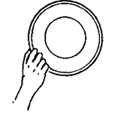
 The Backhand The most common throw is the Backhand release. Stand sideways toward your target, and grip the disc by placing four fingers under the rim of the disc and your thumb on top. Reach across the front of your body, then swing your arm back, releasing the disc towards your target. Tilt the outside edge of the disc down slightly (approx. 30 degrees) upon release and follow through!
The Backhand The most common throw is the Backhand release. Stand sideways toward your target, and grip the disc by placing four fingers under the rim of the disc and your thumb on top. Reach across the front of your body, then swing your arm back, releasing the disc towards your target. Tilt the outside edge of the disc down slightly (approx. 30 degrees) upon release and follow through!

 The Finger-Flip Stand sideways toward your target, and grip the disc by placing your thumb on top of the disc and the first two fingers in the rim. Much like snapping a towel, swing your arm along the side of your body, snapping the disc towards the target. More snap equals more spin. Tilt the outside rim down slightly upon release. Use your wrist snap to propell the disc, not your arm.
The Finger-Flip Stand sideways toward your target, and grip the disc by placing your thumb on top of the disc and the first two fingers in the rim. Much like snapping a towel, swing your arm along the side of your body, snapping the disc towards the target. More snap equals more spin. Tilt the outside rim down slightly upon release. Use your wrist snap to propell the disc, not your arm.

 The Thumber The Thumber is much like the Finger-Flip except for the grip. Stand sideways toward your target, and this time place the thumb in the rim with four fingers on top of the disc. Again, swing your arm along the side of your body, waist-high, snapping the disc toward the target. Slightly tilt the outside rim down upon release.
The Thumber The Thumber is much like the Finger-Flip except for the grip. Stand sideways toward your target, and this time place the thumb in the rim with four fingers on top of the disc. Again, swing your arm along the side of your body, waist-high, snapping the disc toward the target. Slightly tilt the outside rim down upon release.

 The overhand wrist flip For this throw, stand facing your target. Begin with the same grip as the Thumber, then turn your arm and wrist over. With your wrist cocked backward, swing your arm above your shoulder and snap your wrist forward towards the target. Remember to keep the outside edge of the disc tilted slightly downward at the point of release.
The overhand wrist flip For this throw, stand facing your target. Begin with the same grip as the Thumber, then turn your arm and wrist over. With your wrist cocked backward, swing your arm above your shoulder and snap your wrist forward towards the target. Remember to keep the outside edge of the disc tilted slightly downward at the point of release.
TRICK THROWS
Trick throws can be created by modifying the throws previously described. Use momentum from spinning or pivoting to create the snap needed to throw around your back, neck or legs. Be creative and invent new throws with your friends.
UPSIDEDOWN To throw the disc upside down, use the previously shown grips. Release the disc tilted slightly upward (Approx. 30o), instead of downward.
CURVE To throw a Curve shot, simply angle the disc upon release of your throw in the direction of your desired curve. Special precautions should be made in windy conditions.

SKIP SHOTS Skip shots can be made by striking the far edge of the disc on the ground between you and the receiver of the throw. Skip shots are easiest on hard surfaces.
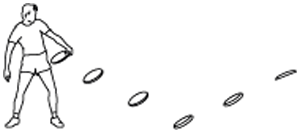
BASIC AND TRICK CATCHES
Catches can be made off of throws from your partner or from your own set-ups, and can be made with either hand. The disc is always spinning, so be sure to make a strong squeeze when catching. Standard catches are made with the thumb up on low catches and the thumb down on high catches. Catches can be made more difficult by spinning around before the catch is made. Below are some examples of beginning and advanced catches, but make up some of your own, that’s half the fun. Catches can be made while standing, running, sitting, lying down or jumping in the air.

Pancake |
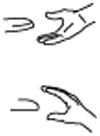
One hand catch; High and Low |
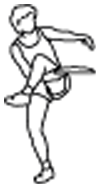
UTL (Under the Leg) |
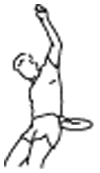
BTB (Behind the Back) |
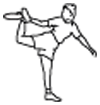
Bad Attitude (Around the Extended Ankle) |

Flamingo (Around One Leg) |

Figure Four (Reverse Under the Leg) |

Behind the Head |

Chair (Around both Legs) |
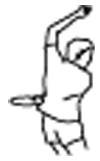
Triple Fake (Around the Body) |
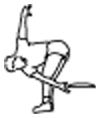
Phlaud (Around the far side of both Legs) |

Gitis (Around the far leg) |
TERMINOLOGY
 Nail Delay – Spinning the disc on your fingernail allows you to do many things. By balancing the spinning disc in the center, you can maneuver it under your legs, around your body and set it up for catches. Move your fingernail in a small circle underneath the spinning disc. Your finger should move in the same direction of the spin. When outside always face the wind.
Nail Delay – Spinning the disc on your fingernail allows you to do many things. By balancing the spinning disc in the center, you can maneuver it under your legs, around your body and set it up for catches. Move your fingernail in a small circle underneath the spinning disc. Your finger should move in the same direction of the spin. When outside always face the wind.
Note: Silicon lubricant is used to create less friction.
 Rim Delay – Similar to the nail delay, this technique involves letting the inside rim of the disc ride on your fingernail. Simply hook your finger so that your nail is the only thing making contact with the disc. This allows you to swoop the disc and create a flowing motion.
Rim Delay – Similar to the nail delay, this technique involves letting the inside rim of the disc ride on your fingernail. Simply hook your finger so that your nail is the only thing making contact with the disc. This allows you to swoop the disc and create a flowing motion.
Spin – The disc spins two ways, clockwise and counter-clockwise. When the disc is thrown with a lot of spin, the flight will be more stable, and the nail delay will last longer. Also, the disc will hold an angle longer, and be more manueverable.
Percussion – Tips and kicks in the center of the disc offer many moves for the novice and professional alike. It is important to make contact as close as possible to the exact center of the disc. The action should be quick and precise for maximum control. Use your fingers, elbow, knee, head, toe or heel to pop the disc into play or to set for a catch. Experiment with trick tips under your leg, behind your back and with your feet.

Air Brushing – By hitting the disc on the outside rim with either the hand or foot, you can maintain spin and keep the disc in play. It is easiest when there is a slight breeze. Angle the disc upward into the wind and brush across the outside rim. The disc will rebound. Repeat the action or make a catch. Indoors, the brushing action can be used to pass the disc to your partner. Experiment with different hits and kicks into the wind or indoors.

Body rolls – Rolling the disc across your body is fun and easy. The most common roll is the chest roll. First of all, make sure to face the wind, then, while leaning your torso back and with the disc tilted towards you, start the roll at your finger tips. Step into the disc to maintain contact between your body and the disc throughout the roll, and watch the disc progress from one hand to the other.
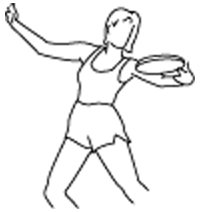
Co-op – Passing the disc between players by center delay, rim delay, air brush, kicks or tips is called co-oping. For routines on the competitive level, these tricks are choreo-graphed to music.
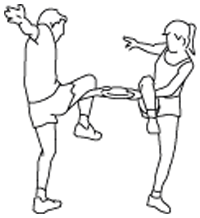
Freestyle Competition
In competitive freestyle disc play, players organize three, four and five minute routines to music, and are judged on execution, artistic impression, variety and difficulty. Tournaments are held worldwide, and exhibitions can often be seen in schools and at special events.
For a complete listing of freestyle events, please contact the Freestyle Players Association at:
Needed Equipment
For a simple game of throw and catch, a disc is all you need. If you desire to expand your play to the nail delay and other advanced moves you might want to spray the bottom of your disc with a dry silicone lubricant. Spraying the disc will make it slick and nearly friction-less, which allows for easier nail and rim delays. Another part of the equipment needs of professional disc athletes are fake fingernails. Since real nails tend to grind down with extensive play, fake nails are used to protect the real nail and give a secure surface for the spinning disc. Other than that, the only requirements for freestyle disc play are open space and you!
Text by Rodney and Bethany Sanchez
Graphics by Gina Sample
Paul Kenny expounds on the Center Delay
Beyond throwing and catching, which are the most fundamental
tools required, initial tooling in my mind has a couple paths.
The outer rim and the center. With the center, you will want
to learn to spin the disc keeping your finger, specifically the
nail, under the center of the disc and in contact with it as
best as you can. This is called a delay. With the outer rim
you want to learn to keep the disc in the air as best you can.
This might include brushing, rolling or kicking and can involve
alot of running around. I will leave the outer rim skills to
one more proficient than I.
When I first learned to delay a disc, I had trouble. I already
knew how to spin a basketball, but had trouble figuring out how
to spin a disc. A spinning basketball, because it has so much
weight away from the center, has a stable center. When you spin
it correctly, the finger “locks” in the center. In fact, I could
spin a basketball on a pencil and hand it to just about anyone
and they could hold it spinning. With a spinning disc, the center
is not stable and the finger wants to drift off center on it’s
own. It takes very small, very quick corrections to maintain
center. It can take some time and repetition to get there.
Further complicating the development of this feel is the gyroscopic
effect intrinsic to spinning objects. When you touch a spinning
disc off center, the disc will “precess”, or turn 90 degrees
from where you touched it. Thus the small corrections discussed
above need to be in the direction of the spin. It will seem
you are always trying to catch up to the correction which wants
to stay 90 degrees ahead of your finger! This results in the
finger seeming to be doing really small circles near the center
of the disc. As you get more proficient, these “circles” and
the corrections get so small that it appears the finger is staying
still in the center of the disc!
Higher level functions such as skids and turnovers will use this
precessive property of discs in a complicated way to achieve
the moves. Skids, or “against the spin” moves work against the
prevailing precession while turnovers are done with the spin
in one direction until the turnover and then with the spin in
the other direction. What complicates it is the need to work
at non-flat angles and switching your brain from one spin’s thinking
to the other.
Paul Kenny



